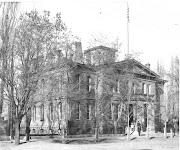Saturday, September 29, 2007
A Question for CC coin experts
Here is a question about CC coins I get asked from time to time and I'm not exactly sure what or how to answer. Can anyone out there help with this question. here 'tis: There are 2 types of 1880-CC Morgan Dollars; the 1880-CC with the rev. of 79 & the 1880-CC rev. of 78 (sometimes an 1880/79-CC rev. of 78). These are two completely different reverses much like the 1875-CC Seated Dime. One version of that dime is the 1875-CC with CC above the bow and the 2nd version with the CC below but both issue types share the same obverse (just like the 1880 Morgans do). Those 2 issues constitute 2 different "types" turning a complete set of CC coins from 110 to 111 coins. Why then should the 1880-CC Morgan be treated any different? Why should there not be then 112 coins in a complete set of CC coins? If anyone can help answer this, please post a reply. All answers appreciated.
Subscribe to:
Post Comments (Atom)






2 comments:
Great question Michael! I don't know if there is a right or wrong answer to it. But it has always been my contention that the difference in category classification between the two varieties of the 1875-CC dime and the two reverse varieties of the 1880-CC silver dollar is a result of who ordered the specific dies to be used. The Bureau of the Mint orchestrated the mintmark location modifications on the 1875-CC (and 1875-S) dimes, sending both reverse dies to the corresponding mints. I have never seen a valid explanation for this. However, Walter Breen speculated that it constituted one of several attempts by Chief Engraver William Barber to exercise his power to resolve design problems (and possibly flex his muscles of authority).
In the case of the 1880-CC silver dollars, the use of the leftover reverse dies from 1878 resulted from an arbitrary decision made by the Carson Mint's management (Superintendent Crawford, Coiner Dague). I don't have a record of what prompted the decision to use the reverse dies from 1878 on a portion of the dollars minted in 1880, but whatever the reason, it was not due to an official design change ordered by the Bureau of the Mint, similar to what occurred with the 1875-CC dimes. To state it simply, the "Above Bow" and "Below Bow" varieties of the 1875 dimes were issued by order of the government, whereas the two reverse varieties on 1880-CC dollars were issued at the discretion of the Carson Mint’s management. The dime varieties of 1875 are as “official” as say, the “With” and “Without Arrows” varieties of 1873; whereas the two reverses appearing on the 1880-CC dollars, fall into the category of die varieties native to the issuing branch mint. Thus, both dime varieties are included in the 111-piece set of regular issues from the Carson Mint, and the two reverse varieties of 1880 dollars are in the subset of “CC” Morgan dollars, which includes all the VAM varieties.
There’s no law preventing a person from adding any extra variety to the complete set of “CC” coins, which opens the door to a myriad of possibilities, such as the inclusion of the 1875-S/CC Trade dollar, the 1900-O/CC Morgan dollar, and the “Non-cancelled” and “Cancelled Die” 1878-CC quarters. Yet, tradition advocates defining a complete set as all of the regularly issued date/denomination combinations from the mint in question, exclusive of local mint-caused varieties.
But you’ve opened up an interesting topic of discussion Michael, and I’d like to hear other member’s comments.
You establish the criteria for the collection you want. Yes, there are 2 different hubs that were used for 80 CC Morgan dollars, the rev of '78 (parallel arrow feathers), and the rev of '79 (slanted arrow feathers). If you wanted more, you could add the Top 100 varieties, or all the VAM varieties listed by Van Allen. Or, you can target for just 1 example. There's no right or wrong. It's up to you to define your collection.
Post a Comment